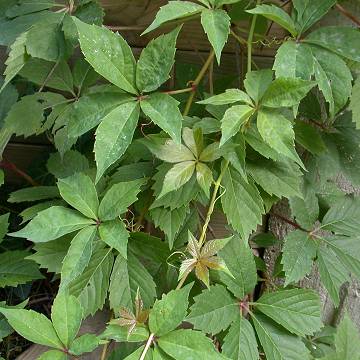

Parthenocissus inserta - (image 1 of 4)
Taxonomy
Family: Vitaceae
Habitat
Clambers over shrubs and small trees in more open areas than P. quinquefolia.
Associates
In the gravel of railroad ballast, it is found with Acer negundo, Ambrosia artemisiifolia elatior, Ambrosia trifida, Apocynum sibiricum, Asclepias syriaca, Convolvulus sepium, Equistium laevigatum, Euphorbia maculata, Rubus occidentalis, Solidago altissima, Symphoricarpos occidentalis.
Distribution
Quebec and New England to NJ, west to Manitoba and IN, west to WY, UT, AZ, and TX. The USDA shows this plants distributed throughout the western U.S.
Morphology
Woody vine. Leaves alternate, palmate compound; leaflets 5, elliptic to obovate, toothed. Tendrils 3-5 branched, twining but without adhesive discs. Inflorescence dichotomously branched, without a central axis. Flowers perfect, greenish; sepals 5; stamens 5. Fruit a blue-black berry.
Notes
Flowers mid July to early August.
Wetland indicator: Facultative Upland
Very similar to Virginia Creeper but less capable of climbing on solid surfaces because it lacks adhesive discs on the tendrils.
Also called Woodbine or Grape Woodbine. Although I am using the scientific name provided by Swink & Wilhelm, this plant would apply to P. vitacea (Knerr) Hitchc. according Gleason & Cronquist. The latter suggests that the name P. inserta could have been misapplied.
References
Gleason, Henry A. and A. Cronquist. 1991. Manual of Vascular Plants of Northeastern United States and Adjacent Canada. Second Ed.
The New York Botanical Garden. Bronx, NY
Swink, F. and G. Wilhelm. 1994. Plants of the Chicago Region.
Indiana Academy of Science. The Morton Arboretum. Lisle, Illinois.
USDA, NRCS. 2002. The PLANTS Database, Version 3.5 (http://plants.usda.gov).
National Plant Data Center, Baton Rouge, LA 70874-4490 USA.
|
Michael Hough © 2005 |